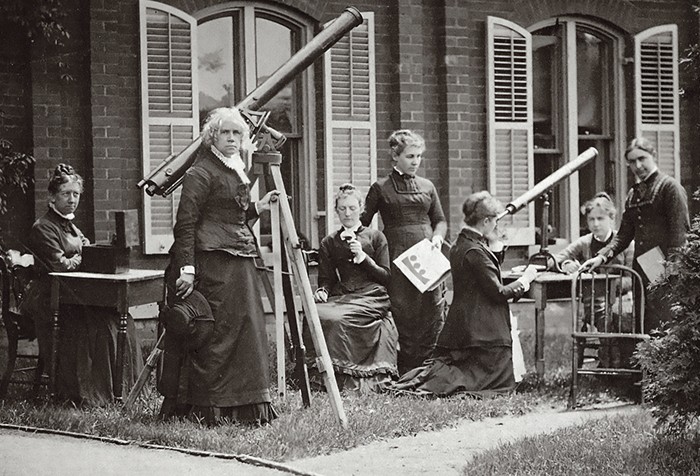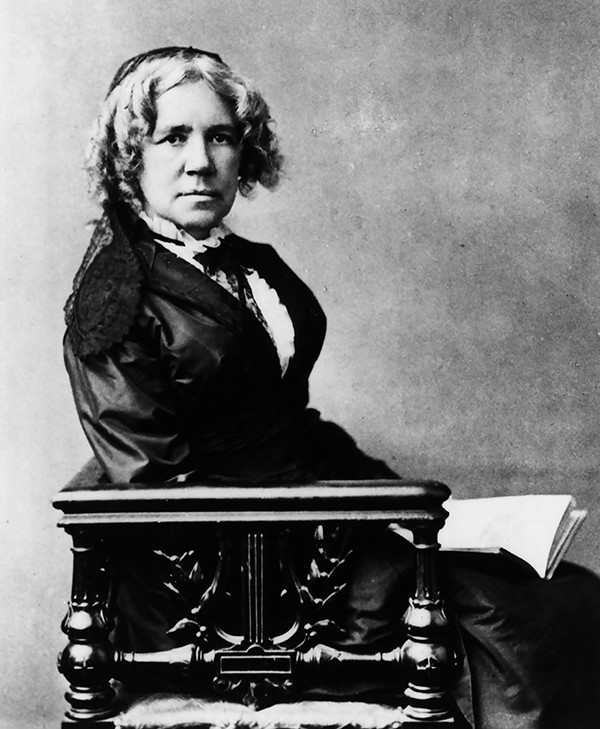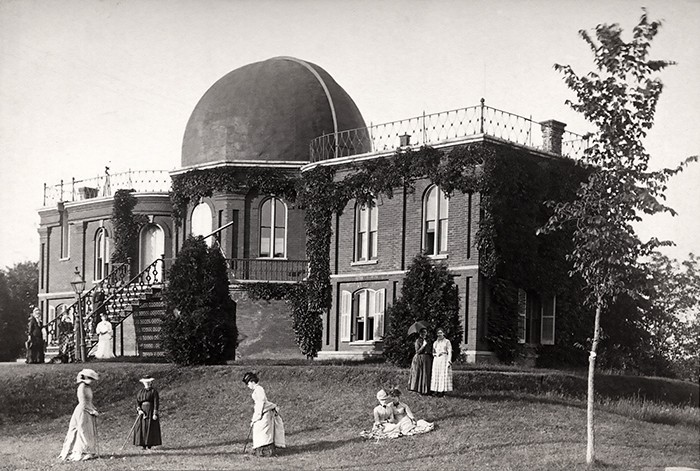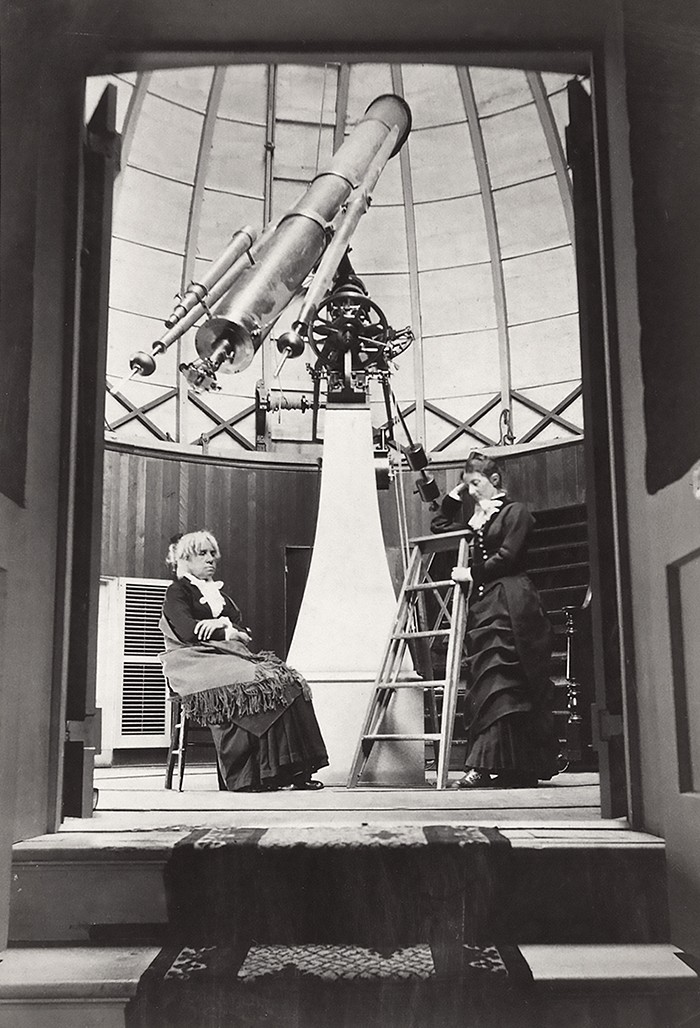
Maria Mitchell (second from left) and her students measure the Sun’s rotation from the movement of sunspots.Credit: ID 08.09.05, Archives & Special Coll., Vassar College Lib.
She was the first woman in the United States to become a professional astronomer, and a dauntless champion of science education for women. Maria Mitchell, whose bicentenary is celebrated this August, was a scientific revolutionary. That is encapsulated in her prophetic speech, ‘The Need for Women in Science’, delivered in 1876 to the Fourth Congress of the Association for the Advancement of Women, in Philadelphia, Pennsylvania. It posed a historic challenge. Mitchell declared that the laws of nature are discovered not through “the hurry and worry of daily toil; they are diligently sought ... And until able women have given their lives to investigation, it is idle to discuss the question of their capacity for original work.” Or, as she put it in her journals: “better to be peering in the spectrograph than on the pattern of a dress”.
Mitchell’s agile mind, pedagogic fire and salty opinions bring extraordinary animation to her varied collection of scientific papers, articles, notebooks and journals. Some were first published by her sister Phebe Mitchell Kendall, in the 1896 Maria Mitchell: Life, Letters, and Journals, just seven years after her death. More recent volumes include Henry Albers’s edited Maria Mitchell: A Life in Journals and Letters (2001) and Renée Bergland’s Maria Mitchell and the Sexing of Science (2008). Independent, combative and original, Mitchell became a major public figure by the end of her life. She “stands out clear and conspicuous”, noted her Scientific American obituary in July 1889, “like an evening star in the heavens she loved so well to study”.
She was born in 1818, into a large Quaker family on the island whaling station of Nantucket, off the Massachusetts coast. It was a place of horizon-gazers, seafarers and lighthouse keepers, where men were often away and Quakerism honoured gender equality. From early childhood she was encouraged to pursue science by her beloved father, a director of the local bank and an amateur astronomer with contacts at Harvard University’s observatory in Cambridge, Massachusetts. Together they scanned the skies using a Dollond telescope from the rooftop ‘walk’ of their house. Early on, Mitchell revealed extraordinary observational powers, natural mathematical gifts and unusual sensitivity to stellar movements and colours.
At 17, she opened her own school; a year later, she was appointed supervisor of the local library, the Nantucket Atheneum. Her constant companion was a notebook, carried in a capacious pocket. Her speech was direct, her ideas increasingly radical. “We cannot accept anything as granted,” she wrote in her journal, “beyond the first mathematical formulae. Question everything else.”

Maria Mitchell argued for women’s education.Credit: Bettman/Getty
Like the German astronomer Caroline Herschel (1750–1848), Mitchell made her name through discovering a comet. On 1 October 1847, on the roof of the Pacific Bank, she spied a new “telescopic comet” five degrees above the pole star. She published a preliminary notice of her finding in the journal of Britain’s Royal Astronomical Society on 12 November, giving her a claim to the gold medal established by the Danish King Frederick VI for the first sighting of any new comet, detectable only by telescope, anywhere in the world.
Mitchell’s claim to priority was authentic, but closely matched by astronomers in Italy, Germany and Britain. She found an enthusiastic champion in Edward Everett, president of Harvard University, who argued her case in various scientific journals, and even wrote personally to the Danish consul in Washington DC. He also wrote drily to a friend in late 1847: “It would be pleasant to have the Nantucket girl carry off the prize from all the greybeards and observatories in Europe.”
She did, and it became known as Miss Mitchell’s Comet. Recognition swiftly followed. By the age of 32, she had become both the first woman elected to the American Academy of Arts and Sciences, and the first to enter the American Association for the Advancement of Science. In 1849, she moved with her father to Boston, Massachusetts, and was appointed an official ‘computer’ calculating tables for the US Nautical Almanac (see S. Nelson Nature 539, 491–492; 2016). She was assigned the orbit of Venus.
That orbit was much too restricting. In 1857, she set out alone to visit the great European observatories, from Greenwich, UK, to Berlin. She took with her one of the earliest star photographs from Harvard, and a volume of Lord Byron’s poetry. Her journals record encounters with George Airy, Britain’s astronomer royal (“the Bear of Blackheath”); William Whewell, master of Trinity College, Cambridge, and coiner of the term ‘scientist’; astronomer John Herschel (Caroline’s nephew, and “a better listener than any man I have met in England”); and the great explorer Alexander von Humboldt.
Not all these meetings went smoothly. She was “riled” by Whewell’s chauvinist teasing while dining at Trinity. He mocked the “disgusting” poems of Elizabeth Barrett Browning, and scorned ideas of extraterrestrial intelligence, as contrary to the design of a benevolent creator. In her travel journal, Mitchell noted that Whewell’s 1853 book The Plurality of Worlds “reasons to this end: “The planets were created for this world; this world for man; man for England; England for Cambridge; and Cambridge for Dr Whewell!”

Students in the grounds of Vassar College’s old observatory in 1879.Credit: ID 08.06.08, Archives & Special Coll., Vassar College Lib.
But her encounter in Florence with British mathematician and writer Mary Somerville was a true meeting of minds. Then 77, Somerville “came tripping into the room, speaking at once with the vivacity of a young person”. Mitchell was dazzled by Somerville’s encyclopaedic enthusiasms, spanning recent discoveries “in chemistry or the discovery of gold in California, of the nebulae ... of the planets”. Above all, Somerville’s books — notably the 1834 On the Connexion of the Physical Sciences (see R. Holmes Nature 514, 432–433; 2014) — had expanded Mitchell’s sense of the scientific world, and confirmed her refusal to be defined by gender. In Rome, Mitchell discovered — as Somerville had, years earlier — that the Vatican Observatory was closed to women. Eventually, Mitchell secured permission to visit, but only during the day.
Mitchell later wrote a study of the friendship struck between astronomer Galileo Galilei and the English poet John Milton in the 1630s. She loved Milton’s evocation in Paradise Lost of Galileo near Florence, entranced by the Moon, “whose orb/Through optic glass the Tuscan artist views/At evening, from the top of Fesole”.
In 1865, she was appointed professor of astronomy at the newly founded Vassar College in Poughkeepsie, New York — one of the earliest woman-only US institutes of higher learning. Her yearly salary was US$800, a figure that Mitchell vigorously disputed after discovering it was a fraction of that paid to male professors. The Vassar observatory, designed by mathematician Charles Farrar, had an 8.4‑metre dome revolved by 16 cast-iron pulleys, along with transit and chronograph rooms; it was regarded as the best equipped in the United States, after Harvard’s. Mitchell lived at the observatory for the next 23 years, and was supplied with a superb 30-centimetre refracting telescope built especially for her use by instrument-maker Henry Fitz.
Under a bust of Somerville, Mitchell mentored a brilliant circle of devoted female students. Her first intake included Mary Whitney, future astronomer, supporter of women’s rights and Vassar professor, who was part of an inner group of six young stars known as the Hexagon. True to Mitchell’s esteem for the arts, they started a tradition of annual ‘Dome parties’, mixing poetry and astronomy with strawberries and cream. The imagination, Mitchell asserted, is part of science, which is “not all mathematics, or all logic, but is somewhat beauty and poetry”.

Maria Mitchell (left) and Mary Whitney in the observatory at Vassar College.Credit: ID 08.07.07, Archives & Special Coll., Vassar College Lib.
As a lecturer, Mitchell became known for pithy sayings. One was: “Study as if you were going to live forever; live as if you were going to die tomorrow.” On Isaac Newton’s genius: “Newton rolled up the cover of a book; he put a small glass at one end, and a large brain at the other — it was enough.” She explained the use of spectroscopy: “The Astronomer breaks up the starlight just as the geologist breaks up the rock with his hammer, and with similar results, he finds copper, sodium and other elements in sun and stars.”
She felt that women had a gift for observational astronomy: “The eye that directs a needle in the delicate meshes of embroidery will equally well bisect a star with the spider web of the micrometer.” She railed against the era’s domestic drudgery, urging her students to pursue full-time careers in science. Above all, she argued that higher education alone would give women independence of mind and drive: “Until women throw off this reverence for [male] authority they will not develop. When they do this, when they come to truth through their investigations ... their minds will work on and on, unfettered.”
Mitchell’s fieldwork was intrepid. In 1873 she travelled to an observatory in Russia, just outside St Petersburg. In 1878, she led an all-female expedition of her best students to observe a solar eclipse from Denver, Colorado (see J. Pasachoff Nature 545, 409–410; 2017). They travelled 3,000 kilometres on the newly completed transcontinental Pacific Railroad, camping and setting up their telescopes on an open plain with a view of the Rocky Mountains. During her final months at Vassar, Mitchell wrote a moving journal entry, comparing the quiet continuity of her meticulous observations of annular eclipses across a gap of more than 50 years. In 1831, she and her father gazed from their Nantucket rooftop; in 1885, she was surrounded by students in a beautifully appointed observatory. “Both days were perfectly cold and clear.” Retirement in 1888 did not suit Mitchell. She died within a year, with a telescope still at her window.
This is a legacy to reckon with. Her archives are treasured at Vassar, and a museum and an association in her name flourish in Nantucket. Her beautiful Henry Fitz telescope has gleaming pride of place in the National Museum of American History, Washington DC. Above all, she should be remembered for her inspirational science teaching, the passionate ex-Quaker and bold proto-feminist so vividly combined. One of her students recalled: “A chance meeting with Miss Mitchell ... gave one always an electric shock. At the slightest contact, a spark flashed.” We can catch it still.

 In retrospect: On the Connexion of the Physical Sciences
In retrospect: On the Connexion of the Physical Sciences
 Women in science: Weird sisters?
Women in science: Weird sisters?
 When suffragists kicked open the lab door
When suffragists kicked open the lab door
 Breaking barriers: the US space programme’s black women mathematicians
Breaking barriers: the US space programme’s black women mathematicians








